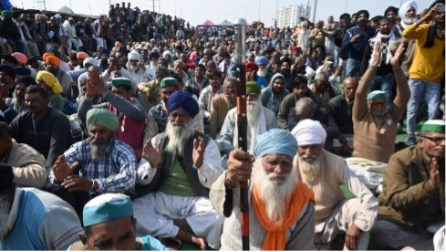
What the protests in India say about the importance of food production in a global pandemic.
By Harry Bignell, London-based advocate
Unrest in New Delhi over the past few months broke international headlines last week as the passionate tug of war over the country’s agricultural sector resulted in clashes between police and protesters.
Farming and agricultural production are vital to India’s economy, with 58% of its 1.3 billion population working in this sector.
Over the past few months, the sector has been shaken as new reforms proposed by Prime Minister Narendra Modi’s government left farmers worried that they could spell the end of guaranteed pricing and could result in plummeting land prices.
What are the proposed changes?
India’s food procurement programme is predicated on a benchmarking systems that sees the state-run Commission for Agricultural Costs and Prices calculate the cost of cultivation and announce Minimum Support Prices (MSPs) for more than 22 commodities annually.
The Food Corporation of India (FCI) then buy rice and wheat at this price from farmers and sell them on to the poor at subsidised prices, with the government compensating (FCI) for their losses.
The three contentious bills that have been proposed would relax rules around sale, pricing and storage, meaning farmers would have to sell their produce at a market price directly to private players, including supermarket chains and agricultural businesses.
What has been the response?
In scenes that have had many people at home reaching for their antibac, thousands of farmers from neighbouring states Punjab and Haryana have chugged into New Delhi on tractors during the COVID-19 pandemic to protest these reforms.
Opposition parties accused the government of flouting parliamentary procedure by passing the bills hurriedly and not listening to their calls for further deliberation. Meanwhile Prime Minister Narendra Modi has defended the bills which he argues are committed to ‘modernising’ the Indian agricultural sector, and has accused protestors of causing ‘insult’ to the country.
Images of thousands of farmers packed together in peaceful protest, and reports of hunger strikes and internet cuts, all in the context of a global pandemic that has infected an estimated half of India’s population, are a chilling reminder that these protest represent a struggle for life and livelihoods from some of the world’s most vulnerable, and yet most vital people.
This unrest is a stark reminder that ‘good food is vulnerable to disruptions’, does not just refer to natural phenomena.
Figure 2 Thousands of farmers blocked a road in Ghazipur near Delhi on Saturday. Credit BBC News (Getty Images)

India’s agricultural sector has faced significant challenges already across the last year at the hands of the COVID-19 pandemic. The national lockdown prompted many migrant workers to move back to their rural hometowns, creating labour shortages and impacting harvests.
Dairy farmers were particularly hard hit, especially those linked to vendor-driven milk markets, due to lower prices for milk, lack of assured procurement, unavailability of animal feed and lack of veterinary services.
An Aljazeera report noted that India’s farming community have already faced challenges with farmland being ‘gobbled up’, often by property developers, and farmers are left with no livelihood, nor adequate compensation.
The barriers between smallholder farmers and equitable livelihoods are many and often complex. Whilst more than half of India’s population work on farms, the sector accounts for barely a sixth of the country’s GDP. Erratic prices, shrinking plots, conniving middlemen, declining productivity are just a few of the issues already facing the sector.
Whilst a recent Reuters article has argued that poorer farmers often do not benefit from MSPs, there are fears that these reforms could favour corporate farming at the expense of independent and smallholder farmers.
It is widely acknowledged by the food security and other development sectors that smallholder farmers are the life blood of global food systems. There are some 500 million smallholder farms around the world which produce about 80% of the food consumed in Asia and sub-Saharan Africa.
So why should the rest of the world care?
India’s agricultural sector has grown significantly since it was categorised as a ‘low-income food-deficient’ country when joining the UN Food and Agricultural Organisation in 1945.
Now, India is self-sufficient in rice and wheat, and produces sufficient food, feed and fibre to sustain around 18% of the world’s population.
The Indian agricultural sector has tendrils reaching across the globe. It is the world’s largest producer of milk, pulses and jute, and the second largest producer of rice, wheat, sugarcane, groundnut, vegetables, fruit and cotton.
Good food begins with farmers. If solidarity and sympathy for their concerns does not draw the global eye to the scenes in New Delhi, the prospect of disruption and shortages in the varied diet many are able to enjoy at the hands of these farmers might.
With both sides seemingly unwilling to concede, and talks between farmer representatives and government Ministers heralding no mutually agreeable solutions thus far, the world will watch in anticipation as this potential threat to global food security continues to unfurl.








